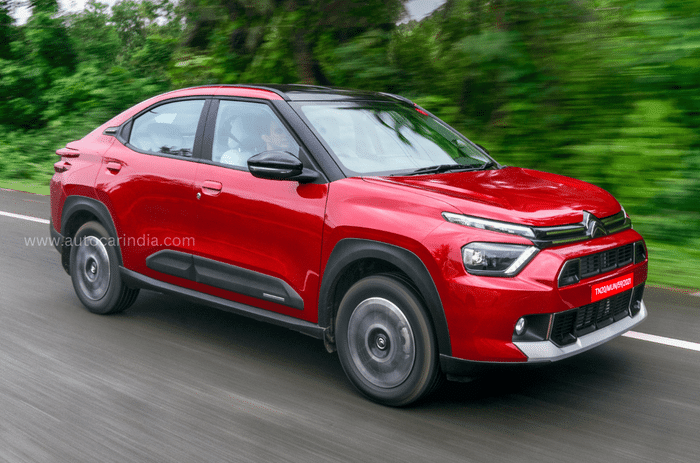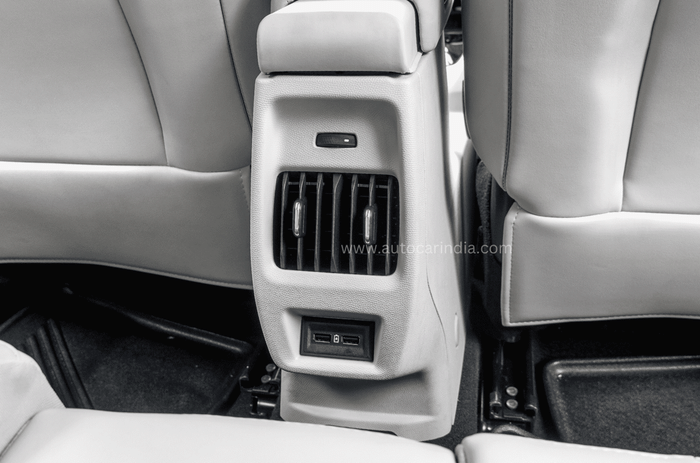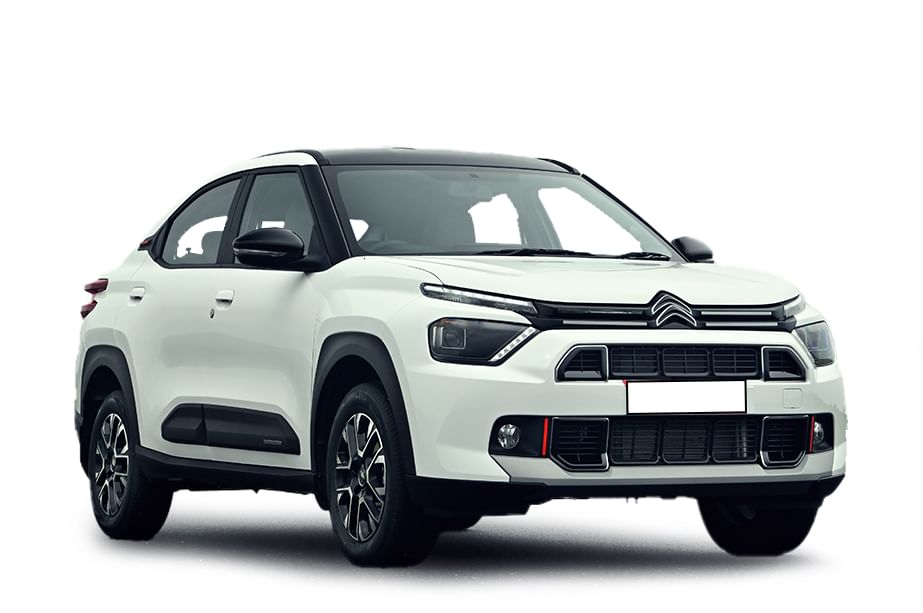Citroen Basalt review: Bringing sexy back
A stunning, well-priced sedan crossover that covers the basics. But is that good enough to get Citroen into the game?
Published on Aug 09, 2024 11:30:00 AM
31,812 Views
Follow us on

Entire boot lid (including the rear windscreen) opens up to reveal a cavernous 470-litre boot.

The Basalt gets rear AC vents
We Like
- Space and comfort
- Engine Performance
- Ride Quality
We Don't Like
- Misses several features
- Auto gearbox needs fine-tuning
The Basalt is Citroen’s fifth offering in India, named after an igneous rock formed under serious geological pressure. The French carmaker has been under pressure over the past five years in the country, failing to make an impression on the sales charts mainly due to poor product planning. However, with the Basalt, the company seems to have taken corrective measures. This mould-breaking coupe covers the basics and reflects Citroen’s seriousness and effort to boost its premium quotient. Has Citroen got it right this time?
Citroen Basalt platform, design, dimensions
The Basalt is based on a heavily localised CMP platform, which also underpins the C3 cross-hatchback, C3 Aircross SUV, and eC3 EV. To keep costs in check, it’s 98 percent localised, with significant parts-sharing among these models. Notably, the front half of the Basalt is shared with its platform mates, and there is a clear demarcation from the B-pillar to the roof, indicating where the differences start. The bonnet, front fenders, windscreen, A-pillar, and front doors are common components.
.png?w=700&c=0)
While the Basalt carries off the family face with its double Chevron logo on its grille and Y-shaped DRLs, it gets some revisions to the lower half of the bumper. In keeping with its crossover-esque image, it has thick plastic body cladding, which has been squared off around the wheel arches, and a 180mm ground clearance. However, its 16-inch wheels seem too small, and because the tyres don’t sit flush with the body, the car appears under-tyred from certain angles.
| Citroen Basalt Price, Mileage, Specifications, Features and Variants | |
|---|---|
| Brand | Citroen |
| Model Name | Basalt |
| Citroen Basalt Price | ₹ 9.35 - 16.08 lakh |
| Citroen Basalt Range/Mileage | Petrol : 18 - 19.5kpl |
| Citroen Basalt Specifications | SUV | 5 doors | 5 seats View All Specs |
| Citroen Basalt Features | LED headlight | 10.25-inch Touchscreen display | 6 airbags View All Features |
| Citroen Basalt Variants | 1.2 Petrol MT You | 1.2 Petrol MT Plus | 1.2 Turbo Petrol MT Plus View All Variants |
The rear of the Basalt has been beautifully styled, featuring a coupe-like sloping roof, a window line pinched towards the rear, and bold character lines that blend neatly into the sculpted tail lamps. Designers have also sculpted twin humps on the roof to cover the boot hinges, which resemble cool aero aids. The steeply sloping rear windscreen ends in a stubby boot with an integrated spoiler.
.png?w=700&c=0)
The Basalt is 4,352mm long, 1,765mm wide and 1,593mm tall. Interestingly, its 2,651mm wheelbase is different from the C3 twins, which stands at 2,640mm for the C3 and 2,671mm for the C3 Aircross.
Citroen Basalt interior
Unlike the antiquated single key, the Basalt now gets a flip-type remote key. However, you still have to contend with the flap-style door handle and bear the sight of the old-school keyhole on the driver’s door. But, from here on, there’s a lot to like inside. Although the cabin design and layout are familiar, the light beige colour scheme, champagne-coloured trims, and large greenhouse brighten the ambience and create an airy feel. The use of soft-touch materials on the dash fascia, the climate control panel, part-leatherette upholstery, and a new armrest console adds an upmarket touch. Additionally, the quality of some elements, such as the roof liner, has improved.
.png?w=700&c=0)
Another improvement in the cabin is the placement of the power window switches on the door pads, where they belong. In the C3 twins, to save costs, the rear window switches were placed on the center console shared between the front and rear. Ergonomically, the Basalt is pretty sorted. The front seats are very comfortable, and finding the right driving position is easy, although the steering gets a tilt function (but misses telescopic adjustment). Additionally, there is a sliding armrest for the comfort of both the driver and front passenger.
.png?w=700&c=0)
There’s a lot to pamper rear occupants. The backrest is nicely angled, and the seat cushioning is well-judged. Comfort is further enhanced by two adjustable concave-shaped headrests, which prevent your head from sliding off if you’re napping. In addition, the top-spec automatic version features unique adjustable thigh support extensions, which can be raised and locked in four steps. For some, the seat squab might hamper comfort even at level 0 as it protrudes a bit, however, others might find it useful. The rear seat in the manual version (without this feature) is equally, if not more, comfortable due to a more natural, flat seat squab. Annoyingly, there are no load sensors, so you will need to fasten the seatbelts even if there are no rear seat occupants; otherwise, the seatbelt reminder will buzz for a few seconds at the start of every journey.
.png?w=700&c=0)
It gets a large segmented parcel shelf that is also rearward sloping to prevent small, loose objects from flying into the cabin during rapid deceleration. Additionally, the entire boot lid, including the rear windscreen, opens to a cavernous 470-litre cargo-carrying capacity.
Citroen Basalt features
Citroen has finally covered the basics with kits like LED headlamps, 16-inch alloys, power-folding mirrors, auto climate control, floor-mounted rear AC vents, and a wireless charging pad with a rubberised base to prevent a phone from sliding. Its digital cluster, carried over from the C3 Aircross, is easy to read, but some more customisable screens would be welcome. The 10.2-inch free-standing touchscreen has also been carried forward with wireless Android Auto and Apple CarPlay, which works seamlessly. The sound quality from its 6-speaker setup is surprisingly good, especially considering it’s a non-branded unit. Appreciably, Citroen offers safety features like 6 airbags, ESP, hill-hold assist, and tyre pressure monitor as standard with the Basalt.
.png?w=700&c=0)
But even though the company has covered the basics, it still lacks a sunroof, auto-dimming inside mirror, ventilated front seats, 360-degree camera, keyless entry, start-stop button, cruise control, and telescopic steering adjustment — features that are offered by most competitors in its segment and even lower segments.
Citroen Basalt engine, performance
The Basalt gets two powertrain options: a 82hp/115Nm 3-cylinder 1.2-litre petrol engine paired with a 5-speed manual gearbox, and a 110hp 3-cylinder 1.2-litre turbo-petrol engine (as tested). This engine produces 190Nm with the 6-speed manual and 205Nm with the 6-speed automatic transmission. The turbo-manual is the most fuel-efficient, with a claimed efficiency of 19.5 kpl; but this can drop far more in the real world. The turbo-automatic has an efficiency of 18.7kpl, while the petrol manual follows with a claimed 18kpl.
.png?w=700&c=0)
Regarding the three-cylinder turbo, its characteristics are similar to those of the C3 twins. It isn’t completely vibration-free initially; if you pay attention, you'll notice the engine fluttering on its mounts during idle. However, these vibrations subside once you start moving. From there on, there’s a lot to like, starting with the engine’s responsive character. Unlike many cars where the throttle feels dulled down for better fuel economy, the Basalt’s crisp accelerator responses, coupled with its nicely judged gear ratios, do well to mitigate turbo lag below 2000rpm. Once the turbo kicks in, performance is brisk, making overtaking effortless and progress rapid. But spin this motor hard, and it gets fairly vocal inside the cabin. While the sound is neither coarse nor unrefined, it is loud enough to coax you to keep the revs lower.
The Basalt produces 190Nm of torque in the manual, though the difference in real-world performance is barely perceptible. Turbo lag, however, is noticeable, especially if you’re caught in the wrong gear and the revs drop below 2000 rpm. The 6-speed manual itself is a sure-slotting gearbox with well-defined gates and an effort-free action, but gear shifts aren’t as buttery-smooth as in some Japanese or Korean rivals out there. If you’re paying close attention, you’ll hear a faint transmission whine from the gearbox every time while decelerating. The clutch feels progressive but it’s a bit weighty.
.png?w=700&c=0)
The automatic is a six-speed Aisin torque converter, which does duty on several other cars in the market. What’s immediately noticeable is its eager creep function that gives you a sense of power when you lift off the brake pedal in D. The shifts aren't seamless. You will notice the torque converter shifting through ratios, especially in lower gears. On Goa’s hilly roads, the gearbox sometimes got confused and kept hunting for the correct gear. However, in manual mode – through the tip lever – this automatic performs much better and is very smooth through the ratios. Steering-mounted paddle shifters would have been a welcome addition here.
Citroen Basalt ride comfort, handling
Ride comfort has always been Citroen’s forte, and we’re happy to report that the Basalt meets the high expectations. Its suspension is tuned for comfort, and even though it doesn’t feature the hydraulic bump stops found in the flagship C5 Aircross, its bump absorption capability is second to none on this side of Rs 20 lakh. In fact, because of its lower centre of gravity, Citroen engineers have gone even softer on the suspension rebound, and as a result, the Basalt is the best riding car based on the C-Cubed platform. It soaks up road imperfections and bad roads very nicely, and what’s also nice is that passengers don’t feel sharp movements or side-to-side rocking movements while going over a battered section of the road. But with the overly soft, comfort-oriented suspension, there's a prominent nose dive on braking, and you can feel some floatiness while cruising at highway speeds, especially at the rear.
.png?w=700&c=0)
The Basalt’s steering is on the heavier side at low and parking speeds, and there's some slack at the dead-ahead position. But, give it some lock and its sharpness and precise nature elevates driver confidence. While attacking corners or driving in a spirited manner, you can feel a fair bit of body roll. However, mechanical grip levels are so good that the Basalt feels rather enjoyable to drive.
Citroen Basalt verdict
With the Basalt, Citroen has put its best foot forward and we’re happy to see the company rectify its previous mistakes, such as the glaring cost-cutting measures and blatant feature omissions. Yes, the Basalt gets more than what the C3 twins had to offer, but it still misses out on bits that premium hatchbacks and compact SUVs and others in its segment have. Also, its automatic gearbox could do with some fine-tuning.
.png?w=700&c=0)
But there’s a lot to like. The Basalt's stunning coupe design, which sits well at the intersection of a sedan and SUV, will be a huge draw for buyers looking to stand out in a crowd. The cabin makes a good impression and in addition to a spacious and comfortable interior, its massive 470-litre boot and 180mm ground clearance make it very practical too. Then, the Basalt’s ride comfort, like other Citroens, remains a huge plus point.
Finally, by pricing it aggressively from Rs 7.99 lakh, Citroen has successfully turned the spotlight on the Basalt. At a price that overlaps with compact SUVs, this stunning sedan-crossover amalgamation is great value for money, making it compelling enough for serious consideration.
Also See:
Tech Specs 
Copyright (c) Autocar India. All rights reserved.




.jpg?w=234&h=156&q=90&c=1)



 Engine
Engine Transmission
Transmission Efficiency
Efficiency Body
Body Suspension
Suspension Brakes
Brakes Dimensions
Dimensions
Comments
Member Login
Personal Details
No comments yet. Be the first to comment.